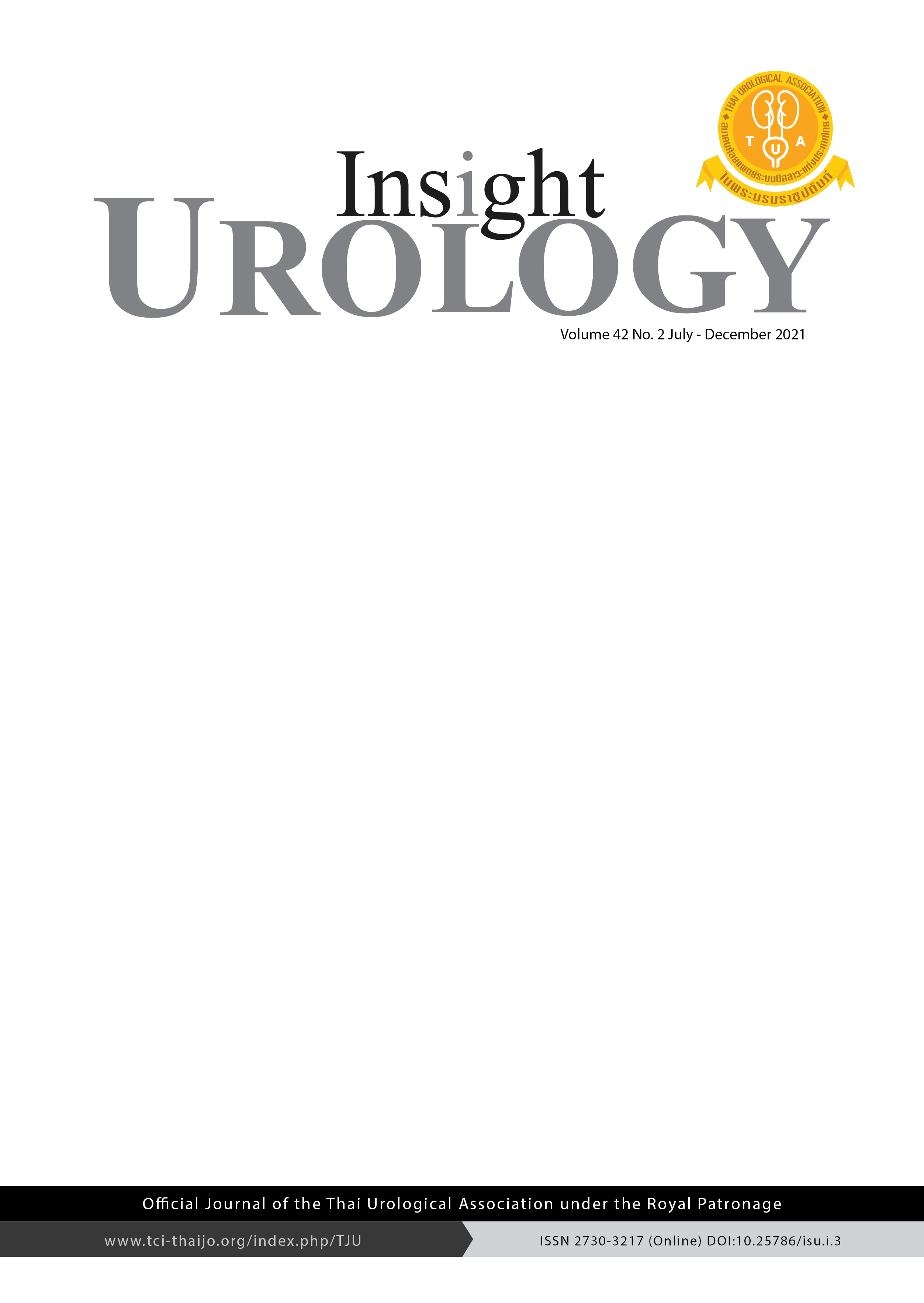One-shot dilation versus metallic dilation technique for access in percutaneous nephrolithotomy: comparison of efficacy, access time and fluoroscopic time
DOI:
https://doi.org/10.52786/isu.a.38Keywords:
Percutaneous nephrolithotomy, one-shot dilation, telescopic metal dilatation, efficacy, access time, fluoroscopic timeAbstract
Objective: The aim of this study was to compare the efficacy, access tract dilation time and fluoroscopic time between the one-shot dilation technique and telescopic metal dilatation technique in patients undergoing percutaneous nephrolithotomy in Nakornping Hospital.
Materials and Methods: Sixty-six patients who underwent percutaneous nephrolithotomy from January 2020 to July 2021 were included in the study and they were randomly divided into two groups. In group 1 (32 patients), telescopic metal dilation was used, in group 2 (33 patients), the one-shot technique was used. Success rates of dilation, access tract dilation time and fluoroscopic time were evaluated.
Results: The success rate of dilation was 100% in both groups. The access tract dilation time was 835.63 ± 309.68 seconds in group 1 and 569.42 ± 314.75 seconds in group 2 (p = 0.001). The fluoroscopic time was 48.16 ± 22.16 seconds in group 1 and 41.97 ± 23.99 seconds in group 2 (p = 0.29). The access tract dilation time of the one-shot dilation technique was statistically significantly shorter than that in the telescopic metal dilatation group. The mean fluoroscopic time of the one- shot dilation technique was shorter than in telescopic metal dilatation but was not statistically significant.
Conclusion: One-shot dilation technique is as effective as telescopic metal dilatation, with a significant reduction in access tract dilation time.
References
Abdelhafez M, Bedke J, Amend B, ElGanainy E, Aboulella H, Elakkad M, et al. Minimally invasive percutaneous nephrolitholapaxy (PCNL) as an effective and safe procedure for large renal stones. BJU Int 2012;110:E1022-6.
Santanapipatkul K. Factors associated with urosepsis following percutaneous nephrolithotomy. Insight Urol 2021;42:56-62.
Wu Y, Xun Y, Lu Y, Hu H, Qin B, Wang S. Effectiveness and safety of four tract dilation methods of percutaneous nephrolithotomy: A meta-analysis. Exp Ther Med 2020;19:2661-71.
Xiong J, Shi Y, Zhang X, Xing Y, Li W. Chinese one-shot dilation versus sequential fascial dilation for percutaneous nephrolithotomy: a feasibility study and comparison. Urol J 2019;16:21-6.
Jin W, Song Y, Fei X. The Pros and cons of balloon dilation in totally ultrasound-guided percutaneous Nephrolithotomy. BMC Urol 2020;20:82.
Peng P-X, Lai S-C, Seery S, He Y-H, Zhao H, Wang X-M, et al. Balloon versus Amplatz for tract dilation in fluoroscopically guided percutaneous nephroli- thotomy: a systematic review and meta-analysis. BMJ Open 2020;10:e035943.
Mastrangelo G, Fedeli U, Fadda E, Giovanazzi A, Scoizzato L, Saia B. Increased cancer risk among surgeons in an orthopaedic hospital. Occup Med (Lond) 2005;55:498-500.
Frattini A, Barbieri A, Salsi P, Sebastio N, Ferretti S, Bergamaschi E, Cortellini P. One shot: a novel method to dilate the nephrostomy access for per- cutaneous lithotripsy. J Endourol 2001;15:919-23.
Thomas K, Smith NC, Hegarty N, Glass JM. The Guy’s stone score--grading the complexity of percutaneous nephrolithotomy procedures. Urology 2011;78:277-81.
Zuazu JR, Hruza M, Rassweiler JJ, de la Rosette JJ. The Clavien classification system to optimize the documentation of PCNL morbidity. Arch Ital Urol Androl 2010;82: 20-2.
Chiancone F, Meccariello C, Fedelini M, Giannella R,Fedelini P. Four dilation techniques in percutaneous nephrolithotomy: a single-institute comparative analysis. Minerva Urol Nephrol 2021;73:253-9.
Srivastava A, Singh S, Dhaya lIR, RaiP. A prospective randomized study comparing the four tract dilation methods of percutaneous nephrolithotomy. World J Urol 2017;35:803-7.
Nour HH, Kamal AM, Zayed AS, Refaat H, Badawy MH, El-Leithy TR. Single-step renal dilatation in percutaneous nephrolithotomy: A prospective randomised study. Arab J Urol 2014;12:219-22.
Amirhassani S, Mousavi-Bahar SH, Kashkouli AI, Torabian S. Comparison of the safety and efficacy of one-shot and telescopic metal dilatation in percutaneous nephrolithotomy: a randomized controlled trial. Urolithiasis 2014;42:269-73.
Aminsharifi A, Alavi M, Sadeghi G, Shakeri S, Afsar F. Renal parenchymal damage after percutaneous nephrolithotomy with one-stage tract dilation technique: a randomized clinical trial. J Endourol 2011;25:927-31.
Falahatkar S, Neiroomand H, Akbarpour M, Emadi SA, Khaki N. One-shot versus metal telescopic dilation technique for tract creation in percutaneous nephrolithotomy: comparison of safety and efficacy. J Endourol 2009;23:615-8.
Amjadi M, Zolfaghari A, Elahian A, Tavoosi A. Percutaneous nephrolithotomy in patients with previous open nephrolithotomy: one-shot versus telescopic technique for tract dilatation. J Endourol 2008;22:423-5.
Peng P-X, Lai S-C, Ding Z-S, He Y-H, Zhou L-H, Wang X-M, et al. One-shot dilation versus serial dilation technique for access in percutaneous nephrolithotomy: a systematic review and meta-analysis. BMJ Open 2019;9:e025871.
Trisakul Y. Percutaneous Nephrolithotomy in Patients with Renal Calculi at Yasothorn Hospital during 2012-2013 and Nakhonphanom Hospital during 2017-2019. J Dep Med Serv 2020;3:13-17.
Amornratananont N, Sangkum P, Phengsalae Y, Leenanupunth C. The impact of body mass index on perioperative outcomes in patients undergoing percutaneous nephrolithotomy. Lampang Med J 2019;2:71-9.
Ahmadmusa N. Treatment of renal stones by standard percutaneous nephrolithotomy versus modified mini percutaneous nephrolithotomy in Yala Hospital: A comparative study. Insight Urol 2021;41:57-62.
Baralo B, Samson P, Hoenig D, Smith A. Percutaneous kidney stone surgery and radiation exposure: A review. Asian J Urol 2020;7:10-7.



